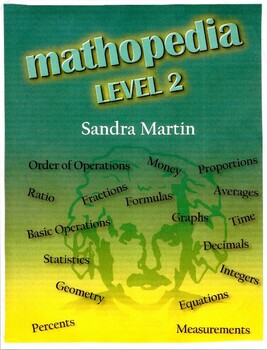Mathopedia, Level 2, Complete Edition
- PDF
Description
Math made easy: Mathopedia, Level 2 is like an encyclopedia of 118 pages of math skills, sequentially organized from addition to pre-algebra. Mathopedia is a high-interest math reference for students have difficulty with math. Students easily look up a skill presenting difficulty. Mathopedia contains simple, one-page explanations of how to easily do the math skills listed below:
Here is a complete list of all the one-page skills covered:
Place Value, Rounding Whole Numbers, Greater Than and Less Than, Addition, Commutative Property of Addition, Associative Property of Addition, Line Graph, Bar Graph, Venn Diagrams, Subtraction, Money-Counting Change, Time, Multiplication Tables, Powers-Exponents, Multiplication-One Digit, Multiplication-Two Digits, Multiplication-Three Digits, Multiplication of Whole Numbers by 10-100-1000, Commutative Property of Multiplication, Associative Property of Multiplication, Distributive Property, Square Root, Division Signs, Division With A One-Digit Divisor, Division With A Two-Digit Divisor, Division With A Three-Digit Divisor, Estimation, Testing Tip-Division Jargon, Order of Operations, Averages, Statistics-Mode-Frequency Distribution Tables, Statistics-Range-Median-Mean, Stem and Leaf Plots, Box and Whisker Plots, Scientific Notation, Patterns and Sequencing, Scale of Miles, Inverse Operations, The Decimal Point, Decimal Place Value, Reading and Writing Decimals in Number Form, Reading and Writing Decimals in Word Form, Comparing Decimals, Ordering Decimals, Rounding Decimals, Addition of Decimals, Subtraction of Decimals, Multiplication of Decimals, Multiplication of Decimals by 10-100-1000, Division of Decimals, Division of Decimals by 10-100-1000, The Metric System–Prefixes-Symbols-Values, The Metric System-Objects in the World, The Metric System-Conversions, Fraction Terminology: Fraction, Numerator, Denominator, Division Symbol, Proper Fraction, Improper Fraction, Fraction Equal to 1, Mixed Number, Equivalent Fractions, Lowest Terms, Divisibility Rules, Factors, Primes, and Composites, Factor Trees, Greatest Common Factor (GCF), Fraction Reducing Rules, Improper Fraction to Mixed Number, Addition of Like Fractions, Subtraction of Like Fractions (No Borrowing), Subtraction of Like Fractions (With Borrowing), Least Common Multiple (LCM), Equivalent Fractions, Comparing Fractions, Addition and Subtraction of Fractions with Uncommon Denominators, Subtraction of Fractions Using Borrowing and with Uncommon Denominators, Mixed Number to Improper Fraction, Multiplication of Fractions, Reciprocals, Division of Fractions, Decimals to Fractions, Fractions to Decimals, English Measurement–Length-Liquid-Dry-Weight (Mass), English Measurement-The Ruler, Temperature-Fahrenheit and Celsius, Geometry–Vocabulary-Point-Line-Line Segment-Ray-Intersecting Lines-Plane, Congruent,-Perpendicular and Parallel, Circles, The Protractor, Acute-Right-Obtuse-Straight Angles, Vocabulary-Angles, Triangles Classified by Angles, Triangles Classified by Sides, Polygons, Quadrilaterals, Solids, Perimeter-Area-Volume, Ratio, Proportions, Unit Pricing, Scale Drawings, Changing Percents to Decimals and Decimals to Percents, Changing Percents to Fractions and Fractions to Percents, Three Types of Percent–Type 1-Percent of a Number is an Unknown Number, Three Types of Percent–Type 2-Percent of an Unknown Number is a Number, Three Types of Percent–Type 3-Unknown Percent of a Number is a Number, Percent of Increase and Decrease, Sales-Discounts, Tax, Simple Interest, Pictographs, Circle or Pie Graphs, Probability, Tree Diagrams, Integers-The Number Line and Absolute Value, Integers-Addition, Integers-Subtraction, Integers-Multiplication, Integers-Division, Points on a Coordinate System, Pi – p, Solving Equations, Using Formulas, A Strategy to Solve Math Problems in Everyday Life and for Assessments – Problem and Answer Key
1. Use Mathopedia to look up math skills that coincide with the math lesson. Use the one-page tricks and tips to learn the math skill in a memorable way.
2. Mathopedia, Levels 1 and 2 books complement each other page by page. Level 1 boasts fewer words and easier problems for understanding math basics. Level 2 has extra vocabulary and uses more difficult problems but mirrors Level 1 in instruction.
3. The one-page tricks and tips help all ability levels.
4. Mathopedia uses a part-to-whole method of teaching and is easily used to further understand problems in any math program.
5. Students that struggle with math may want to use Mathopedia skill pages during a test as a prompt.
6. Great for students with limited English proficiency and those with reading difficulties. Words are limited with more visual examples to explain skills.





